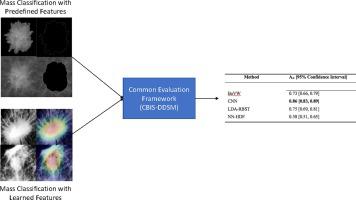Journal of Biomedical informatics ( IF 4.0 ) Pub Date : 2020-12-11 , DOI: 10.1016/j.jbi.2020.103656 Rebecca Sawyer Lee 1 , Jared A Dunnmon 2 , Ann He 2 , Siyi Tang 3 , Christopher Ré 2 , Daniel L Rubin 4

|
Purpose
To compare machine learning methods for classifying mass lesions on mammography images that use predefined image features computed over lesion segmentations to those that leverage segmentation-free representation learning on a standard, public evaluation dataset.
Methods
We apply several classification algorithms to the public Curated Breast Imaging Subset of the Digital Database for Screening Mammography (CBIS-DDSM), in which each image contains a mass lesion. Segmentation-free representation learning techniques for classifying lesions as benign or malignant include both a Bag-of-Visual-Words (BoVW) method and a Convolutional Neural Network (CNN). We compare classification performance of these techniques to that obtained using two different segmentation-dependent approaches from the literature that rely on specific combinations of end classifiers (e.g. linear discriminant analysis, neural networks) and predefined features computed over the lesion segmentation (e.g. spiculation measure, morphological characteristics, intensity metrics).
Results
We report area under the receiver operating characteristic curve (AZ) values for malignancy classification on CBIS-DDSM for each technique. We find average AZ values of 0.73 for a segmentation-free BoVW method, 0.86 for a segmentation-free CNN method, 0.75 for a segmentation-dependent linear discriminant analysis of Rubber-Band Straightening Transform features, and 0.58 for a hybrid rule-based neural network classification using a small number of hand-designed features.
Conclusions
We find that malignancy classification performance on the CBIS-DDSM dataset using segmentation-free BoVW features is comparable to that of the best segmentation-dependent methods we study, but also observe that a common segmentation-free CNN model substantially and significantly outperforms each of these (p < 0.05). These results reinforce recent findings suggesting that representation learning techniques such as BoVW and CNNs are advantageous for mammogram analysis because they do not require lesion segmentation, the quality and specific characteristics of which can vary substantially across datasets. We further observe that segmentation-dependent methods achieve performance levels on CBIS-DDSM inferior to those achieved on the original evaluation datasets reported in the literature. Each of these findings reinforces the need for standardization of datasets, segmentation techniques, and model implementations in performance assessments of automated classifiers for medical imaging.
中文翻译:

在公共乳房X线摄影数据集上比较无分割和依赖分割的乳腺肿块计算机辅助诊断
目的
比较用于对乳房 X 线摄影图像上的肿块病变进行分类的机器学习方法,这些方法使用通过病变分割计算的预定义图像特征,与在标准公共评估数据集上利用无分割表示学习的方法。
方法
我们将多种分类算法应用于筛查乳腺 X 线摄影数字数据库 (CBIS-DDSM) 的公共精选乳腺成像子集,其中每个图像都包含肿块病变。用于将病变分类为良性或恶性的无分割表示学习技术包括视觉词袋(BoVW)方法和卷积神经网络(CNN)。我们将这些技术的分类性能与使用文献中两种不同的依赖于分割的方法获得的分类性能进行比较,这些方法依赖于最终分类器(例如线性判别分析、神经网络)和在病变分割上计算的预定义特征(例如毛刺测量、形态特征、强度指标)。
结果
我们报告了每种技术的 CBIS-DDSM 恶性肿瘤分类的受试者工作特征曲线 (A Z ) 值下的面积。我们发现,无分割 BoVW 方法的平均 A Z值为 0.73,无分割 CNN 方法的平均 A Z 值为 0.86,橡皮带拉直变换特征的依赖于分割的线性判别分析为 0.75,基于混合规则的平均 A Z 值为 0.58。使用少量手工设计的特征进行神经网络分类。
结论
我们发现,使用无分割 BoVW 特征的 CBIS-DDSM 数据集上的恶性肿瘤分类性能与我们研究的最佳分割相关方法相当,而且还观察到常见的无分割 CNN 模型实质上且显着优于这些模型(p < 0.05)。这些结果强化了最近的研究结果,表明 BoVW 和 CNN 等表示学习技术对于乳房 X 光检查分析是有利的,因为它们不需要病变分割,而病变分割的质量和具体特征在不同数据集之间可能存在很大差异。我们进一步观察到,依赖于分割的方法在 CBIS-DDSM 上实现的性能水平低于文献中报告的原始评估数据集上实现的性能水平。这些发现都强调了在医学成像自动分类器性能评估中对数据集、分割技术和模型实现标准化的需求。











































 京公网安备 11010802027423号
京公网安备 11010802027423号